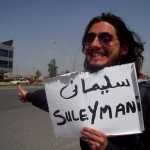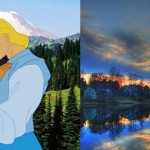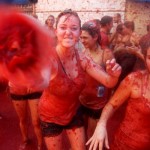Disclaimer: For, one day, we shall have kids, and this is how they shall learn history. 
The Viking Fire Festival? Well, let us first gather some perspective, eh?
There is a lot of noise in this world, kids. Some countries wanting oil, some countries not wanting to give oil; some countries wanting more lands, others wondering why they should part with lands; some people disliking colours, other people rightfully standing up for their colours. But somewhere on the top , maybe because the top is always the cream, there are a few people who don’t seem as bothered and worried and troubled as the rest of us. This ‘top’ that we are talking about here is some of the blobs on the upper reaches of a world map. And these unruffled, cool people we are talking about – we call them ‘The Scandinavians’.
And I am right, right? When last did we hear of the Scandinavians go to war, or steal oil or diamonds, or heh even reach as much as the semi finals of a football world cup? All that they do is put up on that beautiful lights show every year, and send Santa Claus all around the globe to make kids happy.
But once upon a time, a long time before the internet, Harry Potter and mobile phones, from the depths of Scandinavia came a tribe that tore through countries of Europe and were as ferocious as ‘ferocious’ can be visualized – looting, burning, pillaging villages; setting off on long boats and ruling the seas. They were the Vikings.
Scandinavia, as you should know, comprises of three countries – Norway, Sweden and Denmark. And the Vikings they set off in all directions, in the south towards Spain and Constantinople, to the West towards Volga in Russia, and to the East towards Iceland. In that eastbound journey, they also stopped over at a group of islands called Shetland Islands from which they launched their pirate attacks on Norway and Scotland. After terrorizing kingdoms and lands and villages for three hundred years from the 8th to the 11th century, they decided to not write many more pages of history, and the next time we heard a blood curdling cry come from anywhere in that region was in 1996 when a young lad called Richard Kraijeck beat Pete Sampras enroute to win Wimbledon.
In the nine centuries between the events we just spoke of, Viking tales were romanticized, tinkered around with and spoilt as much so as to have us believe that the tribe were in essence a group of ‘noble savages’. Aah, wait a minute, you must have read the newspaper comic strip - Hagar the Horrible - right? That scruffy, shaggy, overweight, red beard, helmet-ed adorable man is a Viking warrior all the way. Created by Dik Browne, Hagar is probably our only present day connect to the Vikings.
But surely such a fierce tribe, a set of men that ravaged Europe for over three centuries need to be remembered and spoken about beyond a comic strip? Well as it turns out they are.
For every year, in the Shetland Islands (officially Scottish territory, since 1468), people come together to celebrate Europe’s largest fire festival or the ‘Up Helly Aa’ as it is more popularly known. And it is as dramatic a visual as it can possibly be. For all over Lerwick (capital of Shetland Islands), there are hordes and hordes of Vikings in helmets, battle axes, shield et al, swarming the streets, walking, chanting, screaming, with fire torches in their hands. There is a huge replica of a Viking long ship that is made (it takes several hundred workers over four months to build the galley) and then burnt down by the torch bearers amid loud blaring bands. Touch down at Lerwick on the last Tuesday of January, and it is as if you have been teleported back to Medieval Europe.
A host of volunteers are responsible for the building of the galley, the costumes and the production of more than 1,000 torches. Work begins at the end of October to ensure that everything is ready for the celebrations, but the planning starts almost two years in advance.
In the evening of the festival day, Lerwick becomes a magical world. At the stroke of 7:30 in the evening, all the lights in the town are switched off and a band of 900 costumed ‘guizers’ commence on a torch lit procession through the town, cheered on from the street sides by an audience of over five thousand people. The red glow of the torches and the silhouetted sheepskin and helmet figures as the whole city plunges into darkness is as surreal and chilling a sight as can get.
The procession is lead by the ‘Guizer Jarl’ (Chief Guizer) and he has been waiting for this one night for years, planning, hoping, fantasizing about how he leads his armies through town, how the crowds will be shouting his name, how a lover will look proudly at him, how just how will he bask in the attention that the most memorable day of his life will bring him. There are a number of secrets around Up Helly Aa, and the biggest one of them is the costume that the Guizer Jarl will be wearing on d-day and which Viking character he would represent. He waits at the head of his replica long ship galley and once the procession reaches the burning site, they circle the doomed ship in a slow motion Catherine wheel of fire, the drums beating synchronously.
All of a sudden a rocket explodes and on cue, the Jarl alights from the ship, to resounding cheers all around. A bugle call sounds and all the torches are hurled into the galley. In minutes, as four months of painstaking work is reduced to cinders and ashes, the crowd all sing ‘The Norseman’s Home’ – a riveting elegy that can move the hardiest of men.
Since the festival is in January, it is often accompanied by snow, storm and even gale winds. ”But the festival always takes place on the same day irrespective of snow or gale” says a proud guizer. “Nothing can stop us from burning down that galley on Up Helly Ya Day, mate!” The elements, it seems, just add to the mystique and the surrealness of it all. After the burning down of the galley, there is much pandemonium in town as the ‘guizer squads’ move to the various halls of Lerwick, enacting plays and skits. There are parties thrown all around town , dances and feasts, and it is a Mardi Gras, medieval style.
Add it to your bucket list or that list of ‘Crazy Things I must do in this lifetime’, for there isn’t a similar spectacle you shall see anywhere else in the world. Once upon a time, a group of men left Scandinavia’s shores hoping to conquer new land. For the last 127 years, a small town in an island off Scotland has been trying its hardest to keep those memories alive.
-






















I remember Vikings from the NatGeo or Discovery they had this show about competing warriors from different cultures. Interesting to know about their fire festival. Fire festival seems to be the most oldest of celebration , fire being a mystical element to mankind is worshiped second after Sun.
Seems an interesting festival.. Very nice write-up.
Thanks Ashwini. Lets try and convince you to get there.
These are actual festival pictures or some Hollywood movie stills. I had just heard about Vikings vaguely, thanks for this information.
Heh, these are real pictures from last year’s festival. Looks quite surreal, right. And cheers, glad you liked it.
This fire festival is quite something. As far as I know, the Viking were quite adventurous and did strange things.
Wow it sounds wonderful. In Italy we have local madonna festivals where in evening torch processions are carried out but they don’t sound so exotic!
Sunil, we have seen your blog and your photographs and you are doing some lovely work out there. If you would like to share your work on our travel pages, we would gladly host it.